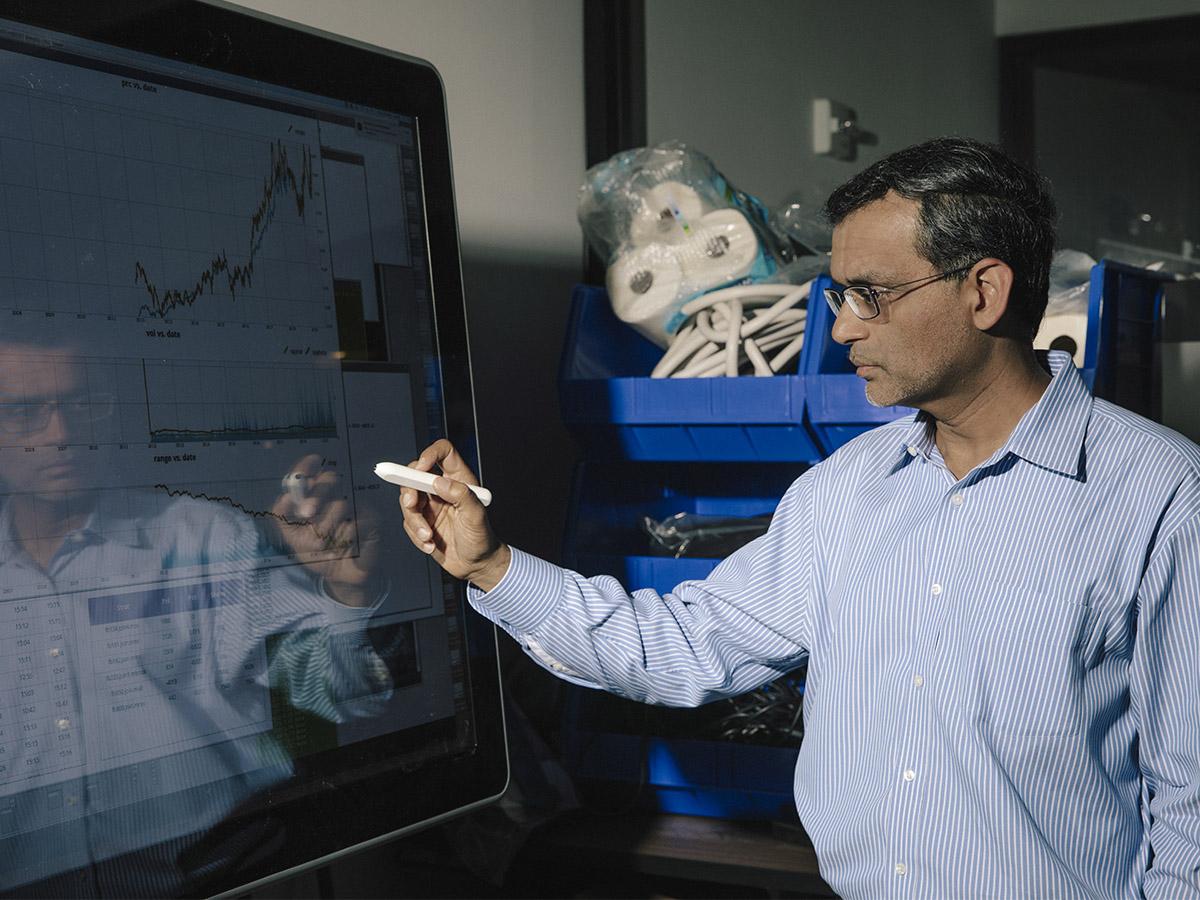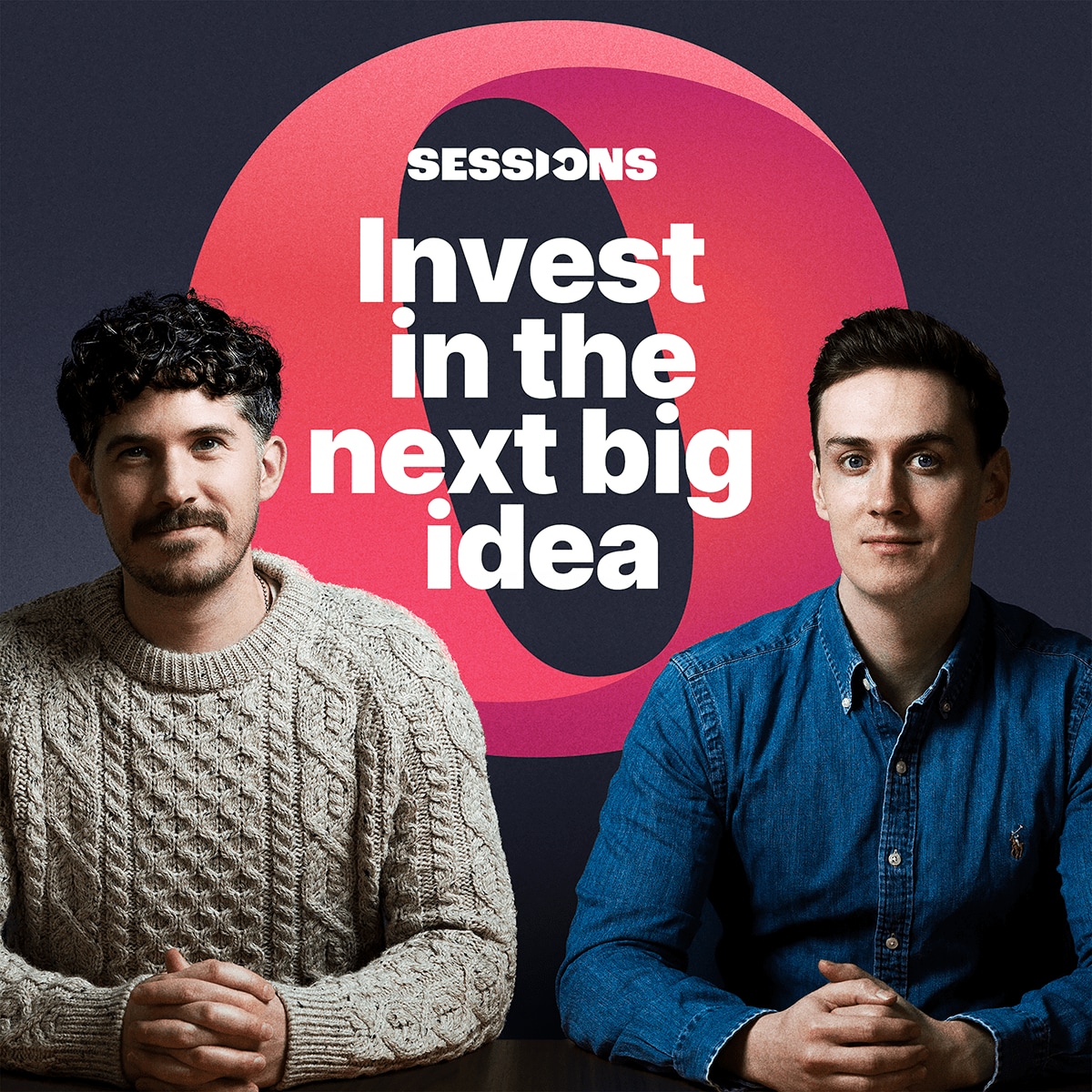Manof Narang claims, “A lot of traders use data to build their beliefs. And because there’s so much data out there it virtually guarantees identifying strategies that look to have statistically significant results, but are in fact absolute trash.”
It’s a characteristically bold gambit from Manoj Narang, who first came to prominence during the 2007 financial crisis when his quantitative firm Tradeworx turned to high-frequency trading – and built a platform for others to do it, which resulted in the company becoming responsible for up to 5% of daily volume on the S&P 500.
As one of the few vocal proponents of high-frequency trading methods – as well as an objector of its ability to influence market price – Narang has earned praise and infamy in equal measure. He defends the method as a way of levelling the playing field for smaller funds and has clashed on stage with financial journalist and bestselling author Michael Lewis, calling Flash Boys, his book on high-frequency trading that claims the practice rigs the market, “a work of fiction”.
A different clash, this time with the board of Tradeworx about its future direction, led Narang to leave the company in 2015. Shortly afterwards, he launched MANA Partners, a $1bn fund aiming to do something different: using statistical arbitrage (the go-to method alongside high-frequency trading strategies for most quants) to emulate what traditional hedge fund managers and discretionary investors do.
“The approach is very fundamental and very structural. It’s basically reading the news and looking at the same information human beings are looking at. Valuation is key,” says Narang.
The approach is a cure for the “curse of dimensionality,” he adds, explaining that traders are able to build an “infinite” number of strategies which wrongly appear to have statistical significance due to the sheer amount of data. Applying prior beliefs and “known facts” to this data, as a discretionary investor would, is a simple way of solving this.
“I work top-down, using models based on known facts. If, like most [traders], you go bottom-up, it results in building black box systems, when nobody can understand how decisions are arrived at, including the architects of the system themselves,” he says.

Automation edge
For Narang, the edge comes from the ability to achieve scale through computer power and automation. “Quantitative and algorithmic trading is just technology applied to investment management to achieve scale and efficiency. The ability to do that kind of analysis for thousands of securities in real time gives you a tremendous advantage. And that's the power of quantitative trading: automating things that have previously taken a lot of human labour and time. It’s no different to the role of technology in any other industry.”
Apply the analogy to Amazon, he continues, “Arguably the most successful company in the global economy – all it has done is automated supply, business processes and logistics to achieve a tremendous amount of scale that traditional retailers simply can't hope to have. And that's essentially the approach that I believe to be a winning one for any investment venture.”
“Quantitative and algorithmic trading is just technology applied to investment management to achieve scale and efficiency”
At a time when the lines between technical and quantitative analysis become blurred with ever-complex new programmes, algorithms and artificial intelligence, it is perhaps the last thing you’d expect high-frequency trader Narang – known for making money through deciding whether to buy or sell in less than 20 microseconds – to be focused on.
Unreliable patterns
In fact, he’s exasperated by how AI is currently being used in trading, which mainly focuses on pattern recognition. Like many quants, Narang – somewhat controversially for the pages of Opto – holds a complete derision for technical analysis. It’s an idea he so firmly believes in that his detailed breakdown of technical analysis – and the use of AI in pattern recognition – is offered up with little prompting.
“Human beings are good at detecting patterns,” he says. “And sometimes that makes sense. When you see somebody’s face it’s a pattern and if you see that pattern again, it's probably the same face. But human beings are also conditioned to see patterns, even when they don't exist. So when you see the same pattern that you saw in the past in terms of market prices, that doesn't mean a damn thing.”
So could it ever be possible for AI to be used to remove human error in technical analysis? Not according to Narang; for him, the method simply doesn’t work.
“If you're going to train a machine to be good at something, or perhaps better than a human being at something, it better be in an area where you can train a human being to be good at it in the first place. But is it possible for somebody to be a good technical analyst? I don't think it is. So, if it's not possible for a human being to be a good technical analyst, how do you train computers to be technical analysts?
“There's no fundamental reason to believe technical analysis works,” he continues. “The evidence is that it doesn’t. I simply don’t believe patterns exist in prices that allow you to forecast the future.”

A difficult start
However, for all of Narang’s infectious conviction in his ideas (often conveyed through grand thought experiments and using Newtonian and Quantum physics), if the most recent stories on MANA’s progress are to be believed, you’d be forgiven for thinking he has lost his way.
Last summer, a year after the MANA fund had started high frequency trading, it was the subject of numerous articles detailing the rocky start to the fund. JP Morgan Chase – MANA’s largest and most high profile backer – pulled its money. One financial blogger went as far to suggest the fund had shut down.
But that’s far from the case, says Narang. “We hit an inflection point in the middle of last year and we're up almost every month since February 2019,” he adds, arguing any initial losses were simply teething problems. He does concede that, having secured a large amount of funding and the pressures that go with this, he may have launched a little too swiftly.
“We possibly made the mistake of trying to fly to the moon before our rocket ship was built,” he says. “This is a very competitive space. We had the capital and were ready to launch, but the systems weren’t fully there yet. It's a matter of hitting that critical mass of capabilities, which is very hard to predict in advance; you make the best guess you can and you go forward.”
Narang won’t be drawn on discussing the impact of losing such a big name, saying only that “there's far more volatility in the hedge fund business model that’s caused by the whims of allocators, than the performance of models.
“Building profitable models is the easy part,” he continues. “But building a business that can withstand the whims of investors and allocators is really challenging because, in my experience, they don't necessarily make the most rational decisions.”
“Building profitable models is the easy part. But building a business that can withstand the whims of investors and allocators is really challenging because, in my experience, they don't necessarily make the most rational decisions”
Low-hanging fruit
Having reached an “inflection point” in the middle of last year, which has prompted some backers to grow their positions, it is still early days for MANA. So for now, Narang says he is focused on targeting “low-hanging fruit” through building models that are based on “very intuitive, economically plausible ideas”.
This pragmatic approach resonates with the rest of his long career to date. Narang graduated from MIT in 1991 with a mathematics and computer science degree. Yet his first trading job wasn’t as a quant; instead, he worked as a bonds trader at Citibank, something which he “wasn’t very good at”.
To remedy this, he automated the rapid-fire decisions he was expected to make. A surprising by-product was that the system discovered risk-free arbitrages that enabled millions of dollars to be made per year with little risk. Narang was hooked. He went on to work on the fixed income arbitrage desk at Goldman Sachs before going it alone to launch Tradeworx in the late 1990s.
Although Tradeworx becoming famous for high-frequency trading, the firm didn’t use high-frequency methods for the first 10 years: only as a reaction to the 2008 financial crisis did it come in.
“We decided to look at high-frequency trading because it can be done with a small amount of capital,” explains Narang. “Volatility was very high, which is indicative of an imbalance between the supply of liquidity and the demand for liquidity. We felt that being a supplier to liquidity in that market would likely be very profitable: and it was pretty much right out of the gate.”
To execute high-frequency trades, Tradeworx had to develop the software capable of processing trades in milliseconds. It was a costly endeavour, but Narang had the answer: to sell the tech to other high-frequency firms – and the US Securities and Exchange Commission, which uses the tech behind Tradeworx’s high-frequency software in regulation of the industry.
“We were just one of many clients of the technology and that didn't cannibalise the revenues at all; in fact, it allowed us to invest significantly more funds on our technology than we would have been able to if we were just profiting from the tech through trading,” he says.
“Your ability to be successful as a quant depends almost exclusively on the quality of your technology, and how much you can spend on developing it. So you'd better be a fully-fledged tech firm if you're going to have any hopes of succeeding as a quant.”
It’s a mantra that Narang follows at MANA, where he has a financial technology arm that has maintained his second prestigious backer that’s still very much in the game: Bank of America.
“Running both businesses side by side covers a lot of duplicative costs and activity,” says Narang. “We've been slowly growing our capabilities and we’re now looking to aggressively commercialise,” he adds.
“Your ability to be successful as a quant depends almost exclusively on the quality of your technology, and how much you can spend on developing it. So you'd better be a fully-fledged tech firm if you're going to have any hopes of succeeding as a quant”
Market impact
The success and wide use of Tradeworx’s software, along with Narang’s long-standing policy of speaking to the media, has led him to regularly having to defend the charge that high-frequency trading can cause wild swings in prices due to the level of volume the practice is responsible for.
His argument against this is simple: volume is not the same as capital, and it is capital, rather than volume, that determines price. “The vast majority of capital that’s invested in the world is invested by human beings making discretionary investments. When you have billions of dollars in the market, you can’t have a short horizon, because it takes a very long time to put on a big position and a very long time to exit it.
“The firms that generate the highest amount of volume control the smallest amount of capital. The firms that have the greatest amount of capital generate the smallest amount of volume. So people get confused. They see all of this computer-generated volume and think computers have taken over Wall Street, but that’s simply not the case: computers are responsible for doing the lion’s share of volume, but volume is not the same thing as capital.”
Narang continues: “If I have a one-week holding period, it means over the course of a week I buy and sell the exact number of shares and wind up with nothing. While I’m purchasing I exert a positive impact on price, but when I sell, I exert a negative impact. Those two cancel exactly. What that tells you is that short-term traders simply cannot exert any durable impact on securities prices; the only durable impact come from buy and hold long-term investors.”
The theory feeds into Narang’s wider narrative of how he sees the market and how to successfully trade it: look at what the high capital discretionary investors are doing. “So if you want to forecast where prices are going to go, it’s best to understand how those people make investment decisions,” Narang concludes.

Looking ahead
Despite his focus on emulating discretionary investors and his derision for how AI is currently used, it doesn’t mean this will always remain MANA’s focus. Narang has a variety of theoretical uses for AI, as well as ideas for how black box systems can be used best.
“We will begin applying some nonlinear methods to domains where we have astronomical amounts of data,” he says, explaining that price modelling concerned with tiny price movements that introduce nonlinearity (whereby the output does not change proportionally to the input changes) is one area of AI he is looking at.
“Nobody has been able to crack this problem using traditional modelling approaches, so that’s a perfect application for AI,” he says. But for now, Narang is focussed on collecting data, refining his systems and earning his low-hanging fruit. “We’ve plucked a lot of it, but there’s still a lot left.”
Disclaimer Past performance is not a reliable indicator of future results.
CMC Markets is an execution-only service provider. The material (whether or not it states any opinions) is for general information purposes only, and does not take into account your personal circumstances or objectives. Nothing in this material is (or should be considered to be) financial, investment or other advice on which reliance should be placed. No opinion given in the material constitutes a recommendation by CMC Markets or the author that any particular investment, security, transaction or investment strategy is suitable for any specific person.
The material has not been prepared in accordance with legal requirements designed to promote the independence of investment research. Although we are not specifically prevented from dealing before providing this material, we do not seek to take advantage of the material prior to its dissemination.
CMC Markets does not endorse or offer opinion on the trading strategies used by the author. Their trading strategies do not guarantee any return and CMC Markets shall not be held responsible for any loss that you may incur, either directly or indirectly, arising from any investment based on any information contained herein.
*Tax treatment depends on individual circumstances and can change or may differ in a jurisdiction other than the UK.
Continue reading for FREE
- Includes free newsletter updates, unsubscribe anytime. Privacy policy


